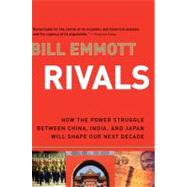
| Asia’s New Power Game | p. 1 |
| A Continent Created | p. 28 |
| China: Middle Country, Central Issue | p. 54 |
| Japan: Powerful, Vulnerable, Aging | p. 96 |
| India: Multitudes, Muddle, Momentum | p. 135 |
| A Planet Pressured | p. 175 |
| Blood, Memory and Land | p. 208 |
| Flash points and Danger Zones | p. 239 |
| Asian Drama | p. 280 |
| Acknowledgments | p. 312 |
| Endnotes | p. 317 |
| Bibliography | p. 325 |
| Index | p. 328 |
| Table of Contents provided by Publisher. All Rights Reserved. |
The New copy of this book will include any supplemental materials advertised. Please check the title of the book to determine if it should include any access cards, study guides, lab manuals, CDs, etc.
The Used, Rental and eBook copies of this book are not guaranteed to include any supplemental materials. Typically, only the book itself is included. This is true even if the title states it includes any access cards, study guides, lab manuals, CDs, etc.
Excerpted from Rivals: How the Power Struggle Between China, India, and Japan Will Shape Our Next Decade by Bill Emmott
All rights reserved by the original copyright owners. Excerpts are provided for display purposes only and may not be reproduced, reprinted or distributed without the written permission of the publisher.